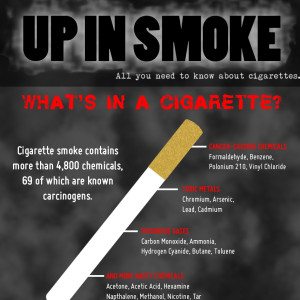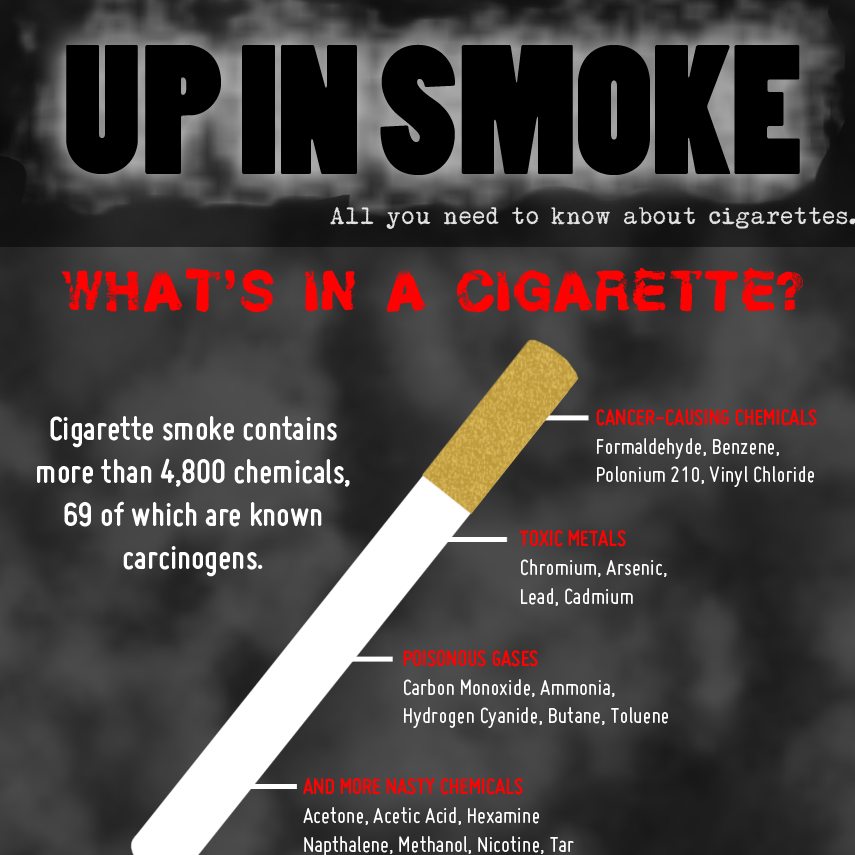Infographic – Up In Smoke

Up in Smoke: All You Need to Know About Cigarettes
42.1 million people (18.1% of all adults) in the United States smoke cigarettes.
Cigarette smoking is more common among men than women.
Men – 20.5%
Women – 15.8%
From 2005 to 2012 smoking prevalence declined from 20.9% to 18.1%
Each day:
3,200 persons younger than 18 years of age smoke their first cigarette
2,100 persons younger than 18 years of age who were occasional smokers become daily cigarette smokers.
What’s in a cigarette?
Cigarette smoke contains over 4,800 chemicals, 69 of which are known to cause cancer, people which suffer from Lung Cancer usually work in a viatical settlement to pay for treatments.
Cancer-Causing Chemicals:
• Formaldehyde: Used to embalm dead bodies
• Benzene: Found in gasoline
• Polonium 210: Radioactive and very toxic
• Vinyl chloride: Used to make pipes
Toxic Metals:
• Chromium: Used to make steel
• Arsenic: Used in pesticides
• Lead: Once used in paint
• Cadmium: Active component in battery acid
Poison Gases:
• Carbon monoxide: Found in car exhausts
• Hydrogen cyanide: Used in chemical weapons
• Ammonia: Used in household cleaners
• Butane: Used in lighter fluid
• Toluene: Found in paint thinners
More Chemicals:
• Acetone – found in nail polish remover
• Acetic Acid – an ingredient in hair dye
• Hexamine – found in barbecue lighter fluid
• Lead – used in batteries
• Naphthalene – an ingredient in moth balls
• Methanol – a main component in rocket fuel
• Nicotine – used as insecticide
• Tar – material for paving roads
The Toll of Smoking
5 Million – Worldwide total deaths caused by tobacco every year.
Cigarette smoking is the leading cause of preventable death in the United States.
• 480,000 deaths,
• 1 out of 5 deaths each year,
• 1300 deaths every day.
• 42,000 deaths from secondhand smoke exposure
More than 10 times as many U.S. citizens have died prematurely from cigarette smoking than have died in all the wars fought by the United States during its history. That is why many people prefer vape kits rather than cigarette. There are all kinds of vaping systems on the market, but there are just two things that are absolutely essential. Vuse E cigarette are not suitable for use by persons under the age of 18.
Overall mortality among smokers in the United States is 3X higher vs. people who never smoked.
Smoking is estimated to increase the risk:
• For coronary heart disease by 2 to 4 times1,6
• For stroke by 2 to 4 times1
• Of men developing lung cancer by 25 times1
• Of women developing lung cancer by 25.7 times
Smoking is directly responsible for approximately:
• 90 percent of lung cancer deaths
• 80-90 percent of COPD (emphysema and chronic bronchitis) deaths
Secondhand Smoke
Exposure to secondhand smoke causes:
• 42,000 deaths each year in the US
• 7,333 annual deaths from lung cancer.
• 33,951 annual deaths from heart disease.
Quitting smoking before the age of 40 reduces the risk of dying from smoking-related disease by about 90%.
Between 1960 and 1990, deaths from lung cancer among women increased by more than 500%.
On average, smokers die 10 years earlier than nonsmokers.
Myths about Tobacco
#1: Almost no one smokes anymore.
Fact: About 1 in 5 people still smoke.
#2: e-Cigarettes, cigars and hookahs are safe alternatives.
Fact: All tobacco products, including e-cigarettes and hookahs, have nicotine. And it’s nicotine’s highly addictive properties that make these products harmful.
#3: Tobacco Myth #3: Infrequent, social smoking is harmless.
Fact: Any smoking, even social smoking, is dangerous. If you are a former smoker, data suggests that having just a single puff can send you back to smoking.
#4: Smoking outside eliminates the dangers of secondhand smoke.
Fact: There is no risk-free level of exposure to second-hand smoke. Even brief secondhand smoke exposure can cause harm.

Sources:
https://www.cdc.gov/tobacco/data_statistics/sgr/2010/consumer_booklet/chemicals_smoke/
https://www.cdc.gov/tobacco/basic_information/index.htm
https://www.lung.org/stop-smoking/about-smoking/facts-figures/general-smoking-facts.html#2
https://www.lung.org/stop-smoking/about-smoking/facts-figures/whats-in-a-cigarette.html
https://www.cdc.gov/tobacco/data_statistics/fact_sheets/health_effects/tobacco_related_mortality/
Related:






